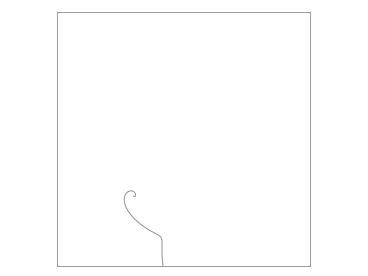An Advanced Evenly-Spaced Streamline Placement Algorithm - PowerPoint PPT Presentation
Title:
An Advanced Evenly-Spaced Streamline Placement Algorithm
Description:
An Advanced EvenlySpaced Streamline Placement Algorithm – PowerPoint PPT presentation
Number of Views:101
Avg rating:3.0/5.0
Title: An Advanced Evenly-Spaced Streamline Placement Algorithm
1
(No Transcript)
2
ADVESS
An Advanced Evenly-Spaced Streamline Placement
Algorithm
Zhanping Liu Robert J. Moorhead II Joe
Groner Visualization Analysis and Imaging
Lab High Performance Computing Collaboratory Missi
ssippi State University
3
Outline
4
Introduction
5
Introduction
- Evenly-Spaced Streamlines (ESS)
6
Introduction
- Evenly-Spaced Streamlines (ESS)
7
Introduction
- Evenly-Spaced Streamlines (ESS)
8
Introduction
- Evenly-Spaced Streamlines (ESS)
- Four problems with ESS placement generation
9
Introduction
- Evenly-Spaced Streamlines (ESS)
- Four problems with ESS placement generation
10
Introduction
- Evenly-Spaced Streamlines (ESS)
- Four problems with ESS placement generation
11
Introduction
12
Introduction
13
ADVESS
14
ADVESS
- Accelerating Placement Generation
15
ADVESS
streamlets shown in red encroach inward near the
field boundaries
16
ADVESS
- Enhancing Placement Quality
- Adaptive step sizing requires line-clipping
against boundaries
17
ADVESS
- Enhancing Placement Quality
- Double-queue seeding strategy
18
ADVESS
- Enhancing Placement Quality
19
ADVESS
- Enhancing Placement Quality
- Obtain the local flow variance magnitude about
convergence divergence - Map the magnitude to 0, 1 use it to locally
adjust threshold distance(s) - The adjusted threshold distance is larger for
laminar areas and smaller for - turbulent areas to reduce cavities without
noticeable uniformity degradation
20
ADVESS
- Detecting Streamline Loops rarely mentioned
in ESS algorithms
- A naïve intra-line inter-sample distance
checking does not work since - the distance between any two successive
samples of a streamline is less - than the threshold distance and a simplistic
intra-line inter-sample - distance checking always terminates advection
from the beginning
- A loop is a closed streamline or an open but
tightly spiraling streamline - A streamline is ill-looping when the distance
between two successive - cycles is less than the advection threshold
distance d_test - A closed streamline is always ill-looping
- A spiraling streamline is ill-looping when it
spirals tightly enough and - then it may be ill-looping as a whole or only
in part - The ill-looping part of a streamline (closed or
spiraling) is what a loop - detector should be really focused on and the
ill-looping part does not - necessarily begin with the seed
21
ADVESS
- Detecting Streamline Loops so far without a
robust solution for ESS
- A strategy using seed-based inter-sample
distance checking does not - work regardless of the use of a seed-based
curve length or accumulated - angle as a threshold to begin such kind of
distance checking
- Our principle is to allow the ill-looping part
of a streamline to advect - as long as within a one-cycle limit and this
encourages a closed - streamline to form the first cycle and a
spiraling streamline to show - the structure in more detail without
cluttering the placement - Our universal, effective, and robust strategy
is to perform both distance - checking and ill-looping angle checking on
each existing sample against - the current sample (NOT the seed) to see
whether or not the ill-looping - part approaches the one-cycle limit and is
going to cause loop problems
- The use of dot-product for ill-looping angle
representation, cell-based - inter-sample distance checking for saving the
approach-the-one-cycle- - limit judgment, and sample-stamp checking for
skipping unnecessary - inter-sample distance checking makes our
strategy a fast solution
22
Results
a loop-free comparison
23
ESS placements generated using our ADVESS
algorithm
ESS placements generated using Jobard-Lefers
algorithm
24
ESS placements generated using our ADVESS
algorithm
ESS placements generated using Mebarki et als
algorithm
25
Results
Three Algorithms in Comparison
Three Algorithms in Comparison
When considering loop-related issues, our
ADVESS is better in overall placement quality
than Mebarki et als algorithm as we will
demonstrate
26
without loop detection ? excessive samples
are generated due to ill-looping streamlines
? more distance checking is needed for them ?
more time consumed
Results
ADVESS adopts an effective, robust, and fast loop
detector
27
(No Transcript)
28
(No Transcript)
29
Hawaii islands
30
Results
31
(No Transcript)
32
(No Transcript)
33
Conclusions
- ADVESS is capable of interactive placement of
evenly-spaced streamlines - RK4-ASSEC allows rapid but accurate streamline
advection, which is - critical to the fast and robust loop
detection strategy - CHPI provides a fast and flexible
curve-sampling scheme to generate evenly- - spaced samples along a streamline for
inter-sample distance control - The use of a large sampling size for CHPI
considerably reduces the amount of - distance checking while maintaining
acceptable uniformity - A double-queue seeding strategy helps preserve
important flow structures and - favors long streamlines in an ESS placement
- Adaptive distance control exploits flow
characteristics to reduce cavities and - discontinuities by context-sensitively
adjusting inter-line threshold distance - An effective, robust, and fast loop detector
is capable of handling complex flow - fields without cluttering an ESS placement
- ADVESS is an order-of-magnitude faster than
Jobard-Lefers algorithm with - better placement quality
- ADVESS is over five times faster than Mebarki
et als algorithm with - comparable placement quality but with more
robust loop detection
34
Conclusions
ADVESS
Welcome to Our ADVESS
Open to Your Advice
Any Questions?
Thank you!






























